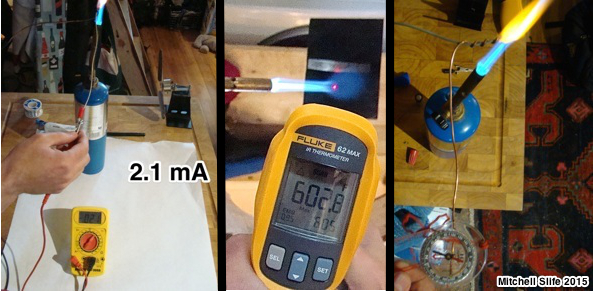Thermoelectric Basics
A single conductor has no voltage potential difference across it (ΔV)- but what if our conductor is made of two different materials joined end to end... and we add heat at their junction?

We've made a thermocouple. Thermocouples can be used to determine temperature by the voltage produced across dissimilar conductors of known composition.
Now if we close our thermocouple circuit we find we have a current!

We have created electric power (Watts) from heat! Unfortunately, the magnitude of our current and potential is not significant considering the heat applied. The current supplied in this thermocouple was not sufficient to disturb a magnetic needle. Only with considerable ingenuity can this principle, the Seebeck effect, yield practical power: the Thermoelectric generator.

Thermoelectric generators (TEGs) began as metal thermocouples arranged in series around a common heat source. This is called a thermopile. The thermopile depicted above left was found in George Hopkins' 1895 Experimental Science. The unit is comprised of a series of antimony/tin thermocouples. The unit's core is heated by a coal gas fire, and is capable of producing 6W. The modern TEG to its right was obtained from a woodstove fan. It has replaced metallic thermocouple elements with semi-conductors, and is capable of producing about 1.5W.
Voltage Applied to a Thermocouple?
A no less remarkable discovery was made a decade after the Seebeck effect's discovery. A current passing through a bimetal circuit will cool at the junction. This means that electric current can be used to refrigerate or pump heat across a conducting surface depending upon the direction of current: the Peltier effect.

Like the Seebeck effect, practical application of the Peltier effect requires particular materials in specific arrangement. But should these requirements be any different?
The same TEG used to generate electric power can be used to transfer heat.
A thermoelectric generator is a reversible heat engine that can become a refrigerator simply by applying current across its thermocouples.The thermoelectric effect entails all of this phenomena: power generation, refrigeration, heating, and thermometry. One might wonder why a device with such versatility -a motionless reversible heat engine- is not more common. The simple answer is efficiency, but there is a very good chance we will be seeing a lot more of this technology in the future.